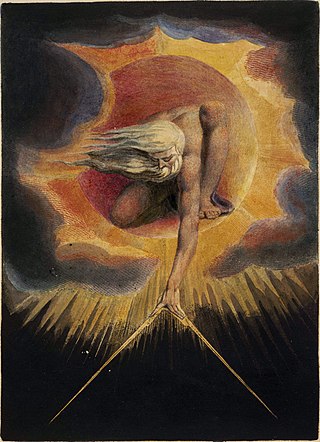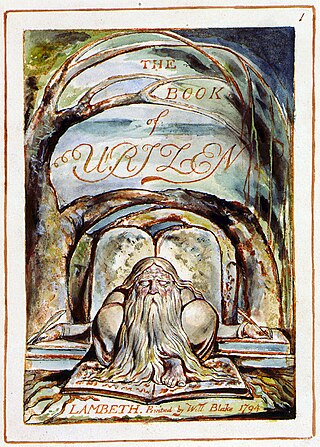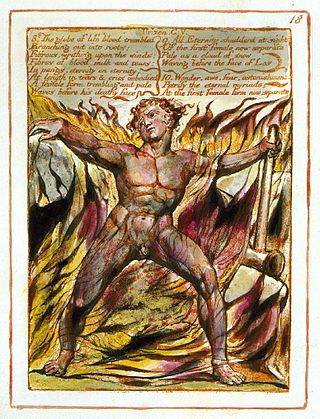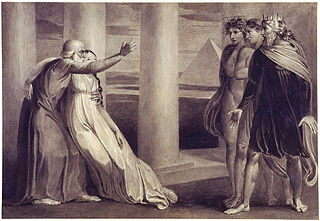
William Blake was an English poet, painter, and printmaker. Largely unrecognised during his life, Blake is now considered a seminal figure in the history of the poetry and visual art of the Romantic Age. What he called his "prophetic works" were said by 20th-century critic Northrop Frye to form "what is in proportion to its merits the least read body of poetry in the English language". His visual artistry led 21st-century critic Jonathan Jones to proclaim him "far and away the greatest artist Britain has ever produced". In 2002, Blake was placed at number 38 in the BBC's poll of the 100 Greatest Britons. While he lived in London his entire life, except for three years spent in Felpham, he produced a diverse and symbolically rich collection of works, which embraced the imagination as "the body of God" or "human existence itself".

In the mythology of William Blake, Urizen is the embodiment of conventional reason and law. He is usually depicted as a bearded old man; he sometimes bears architect's tools, to create and constrain the universe; or nets, with which he ensnares people in webs of law and conventional society. Originally, Urizen represented one half of a two-part system, with him representing reason and Los, his opposition, representing imagination. In Blake's reworking of his mythic system, Urizen is one of the four Zoas that result from the division of the primordial man, Albion, and he continues to represent reason. He has an Emanation, or paired female equivalent, Ahania, who stands for Pleasure. In Blake's myth, Urizen is joined by many daughters with three representing aspects of the body. He is also joined by many sons, with four representing the four elements. These sons join in rebellion against their father but are later united in the Last Judgment. In many of Blake's books, Urizen is seen with four books that represent the various laws that he places upon humanity.
The prophetic books of the English poet and artist William Blake contain an invented mythology, in which Blake worked to encode his spiritual and political ideas into a prophecy for a new age. This desire to recreate the cosmos is the heart of his work and his psychology. His myths often described the struggle between enlightenment and free love on the one hand, and restrictive education and morals on the other.

Orc is a proper name for one of the characters in the complex mythology of William Blake. A fallen figure, Orc is the embodiment of rebellion, and stands opposed to Urizen, the embodiment of tradition.

"The Tyger" is a poem by the English poet William Blake, published in 1794 as part of his Songs of Experience collection and rising to prominence in the romantic period. The poem is one of the most anthologised in the English literary canon, and has been the subject of both literary criticism and many adaptations, including various musical versions. The poem explores and questions Christian religious paradigms prevalent in late 18th century and early 19th century England, discussing God's intention and motivation for creating both the tiger and the Lamb.

"The Lamb" is a poem by William Blake, published in Songs of Innocence in 1789.

Songs of Innocence and of Experience is a collection of illustrated poems by William Blake. It appeared in two phases: a few first copies were printed and illuminated by Blake himself in 1789; five years later, he bound these poems with a set of new poems in a volume titled Songs of Innocence and of Experience Shewing the Two Contrary States of the Human Soul. Blake was also a painter before the creation of Songs of Innocence and Experience and had painted such subjects as Oberon, Titania, and Puck dancing with fairies.

The Book of Thel is a poem by William Blake, dated 1789 and probably composed in the period 1788 to 1790. It is illustrated by his own plates, and compared to his later prophetic books is relatively short and easier to understand. The metre is a fourteen-syllable line. It was preceded by Tiriel, which Blake left in manuscript. A few lines from Tiriel were incorporated into The Book of Thel. Most of the poem is in unrhymed verse.

The Book of Urizen is one of the major prophetic books of the English writer William Blake, illustrated by Blake's own plates. It was originally published as The First Book of Urizen in 1794. Later editions dropped the "First". The book takes its name from the character Urizen in Blake's mythology, who represents alienated reason as the source of oppression. The book describes Urizen as the "primeaval priest" and narrates how he became separated from the other Eternals to create his own alienated and enslaving realm of religious dogma. Los and Enitharmon create a space within Urizen's fallen universe to give birth to their son Orc, the spirit of revolution and freedom.

The prophetic books of the 18th-century English poet and artist William Blake are a series of lengthy, interrelated poetic works drawing upon Blake's own personal mythology. They have been described as forming "what is in proportion to its merits the least read body of poetry in the English language". While Blake worked as a commercial illustrator, these books were ones that he produced, with his own engravings, as an extended and largely private project.

Enitharmon is a major female character in William Blake's mythology, playing a main part in some of his prophetic books. She is, but not directly, an aspect of the male Urthona, one of the Four Zoas. She is in fact the Emanation of Los, also male. There is a complex verbal nexus attached. The Zoa Tharmas has emanation Enion, and Eni-tharm(as)-on is one derivation of her name. That should perhaps be read in the inverse direction though, as a construction of the Tharmas/Enion pair's names. Within Blake's myth, she represents female domination and sexual restraints that limit the artistic imagination. She, with Los, gives birth to various children, including Orc.
In the mythological writings of William Blake, Urthona is one of the four Zoas, who were created when Albion, the primordial man, was divided fourfold. Specifically, he is the Zoa of inspiration and creativity, and he is a blacksmith god. His female counterpart is Enitharmon. Urthona usually appears in his "fallen" form, that of Los.

In the mythological writings of William Blake, Los is the fallen form of Urthona, one of the four Zoas, and the embodiment of human creativity and inspiration. He is referred to as the "eternal prophet" and creates the visionary city of Golgonooza. Los is regularly described as a smith, beating with his hammer on a forge, which is metaphorically connected to the beating of the human heart. The bellows of his forge are the human lungs. Los's emanation, Enitharmon, represents spiritual beauty and embodies pity, but at the same time creates the spatial aspect of the fallen world, weaving bodies for men and creating sexual strife through her insistence upon chastity. In the Book of Urizen (1794), Los and Enitharmon have a child, Orc, who is the embodiment of the spirit of revolution. The name Los is, by common critical acceptance, an anagram of Sol, the Latin word for "sun". Los is also the plural form of El, an ancient Hebrew deity. Such innovations are common in many of Blake's prophetic poems.

Tiriel is a narrative poem by William Blake, written c.1789. Considered the first of his prophetic books, it is also the first poem in which Blake used free septenaries, which he would go on to use in much of his later verse. Tiriel was unpublished during Blake's lifetime and remained so until 1874, when it appeared in William Michael Rossetti's Poetical Works of William Blake. Although Blake did not engrave the poem, he did make twelve sepia drawings to accompany the rough and unfinished manuscript, although three of them are considered lost as they have not been traced since 1863.
Paradise Lost has had a profound impact on writers, artists and illustrators, and, in the twentieth century, filmmakers.

Vala, or The Four Zoas is one of the uncompleted prophetic books by the English poet William Blake, begun in 1797. The eponymous main characters of the book are the Four Zoas, who were created by the fall of Albion in Blake's mythology. It consists of nine books, referred to as "nights". These outline the interactions of the Zoas, their fallen forms and their Emanations. Blake intended the book to be a summation of his mythic universe but, dissatisfied, he abandoned the effort in 1807, leaving the poem in a rough draft and its engraving unfinished. The text of the poem was first published, with only a small portion of the accompanying illustrations, in 1893, by the Irish poet W. B. Yeats and his collaborator, the English writer and poet Edwin John Ellis, in their three-volume book The Works of William Blake.

America a Prophecy is a 1793 prophetic book by the English poet and illustrator William Blake. It is engraved on eighteen plates, and survives in fourteen known copies. It is the first of Blake's Continental prophecies.

The Song of Los is one of William Blake's epic poems, known as prophetic books. The poem consists of two sections, "Africa" and "Asia". In the first section Blake catalogues the decline of morality in Europe, which he blames on both the African slave trade and enlightenment philosophers. The book provides a historical context for The Book of Urizen, The Book of Ahania, and The Book of Los, and also ties those more obscure works to The Continental Prophecies, "Europe" and "America". The second section consists of Los urging revolution.
Songs and Proverbs of William Blake is a song cycle composed by Benjamin Britten (1913–76) in 1965 for baritone voice and piano and published as his Op. 74. The published score states that the words were "selected by Peter Pears" from Proverbs of Hell, Auguries of Innocence and Songs of Experience by William Blake (1757–1827). It was premiered at the Aldeburgh Festival in June 1965 by the German baritone Dietrich Fischer-Dieskau (1925–2012) and the composer. The critic William Mann thought that the cycle would be judged "Britten's deepest and most subtle song-cycle"; and John Warrack wrote in The Daily Telegraph that Britten "has, I feel, here come to terms with the darkness and sense of cruelty that has always stalked his art".

Songs of Innocence and Experience is an album by American beat poet and writer Allen Ginsberg, recorded in 1969. For the recording, Ginsberg sang pieces from 18th-century English poet William Blake's illustrated poetry collection of the same name and set them to a folk-based instrumental idiom, featuring simple melodies and accompaniment performed with a host of jazz musicians. Among the album's contributors were trumpeter Don Cherry, arranger/pianist Bob Dorough, multi-instrumentalist Jon Sholle, drummer Elvin Jones, and Peter Orlovsky – Ginsberg's life-partner and fellow poet – who contributed vocals and helped produce the recording with British underground writer Barry Miles.


















